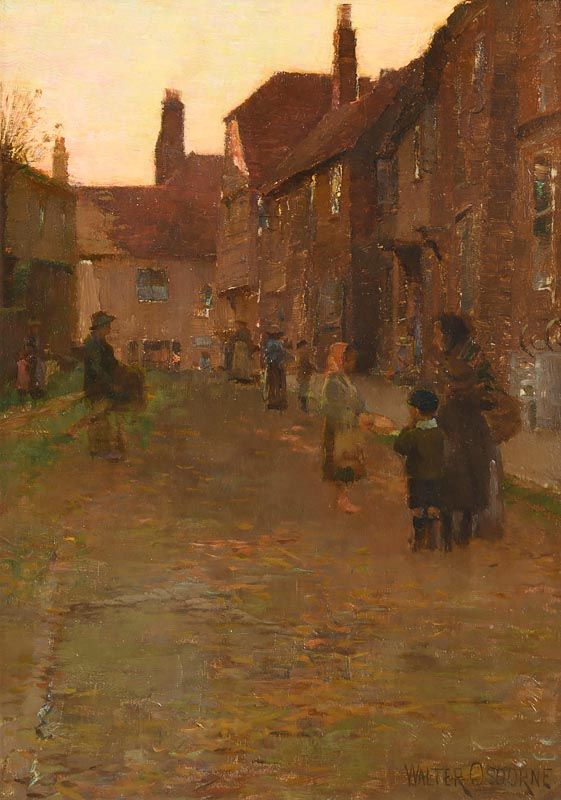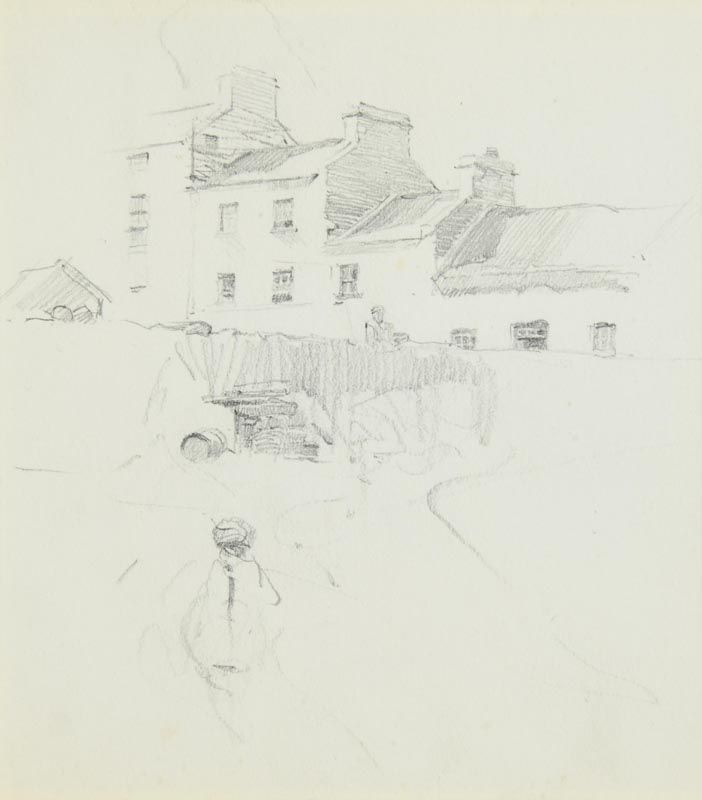Walter Frederick Osborne RHA (1859-1903) An Old Fountain Madrid Watercolour and bodycolour, 35 x 24.5cm (13.75 x 9.75'') Signed Provenance: Given to the Jameson family, Sutton House; Bell Gallery label verso, sold in these rooms 4th October 2006 Cat. No. 56, where purchased by current owner. Walter Osborne's watercolour shows a continental street scene, with men and women at a fountain in a cobbled square, with a donkey standing by, and sunlight on distant buildings. Like many of his contemporaries, Osborne had been much attracted by the subject of women gathering at wells and water pumps, to fetch water and chat, in villages in Belgium and Brittany. For example, his small oil panel ' The pump of St. Nicolas, Antwerp', 1894 shows women in colourful costumes gathered at the pump. In the present watercolour, the figures of the man with his blue jacket and beret could also appear Flemish or Breton. But the architecture, with its terracotta tiled roofs, the bright sunlight and the tethered donkey, indicate that this is a Spanish subject. It dates from Osborne's journey to Spain in 1895, when he filled his sketchbook with lively drawings, but only painted a couple of small oils, and the present rare watercolour. Obsorne travelled with his friend Walter Armstrong recently appomied Director of the National Gallery of Ireland, on train through Europe, via Paris and Bordeaux to Madrid, in December 1895. Armstrong was very interested in the work of Spanish master Velaquez, (on whom he published a monograph the following year), and was keen to share his interest with Osborne. *(2). Since the early nineteenth century, Spain had attached a large number of artists, writers and travellers, from Britain, Ireland and France, fascinated by its vibriant traditional life and festivals, its Moorish heritage and its varied landscapes. Artists and scholars in the Romantic period had discovered its Moorish architecture and the Alhambra at Granada. In the mid - century French writers and painters, such as Manet, Bonnat, Ribot and Carolus - Duran, had of Spainish painting, and this contributed to the development of French realism. Manet's admiration of Goya was also shared by the impressionists and John S. Sargent. Writers such as George Borrow and Walter Starkie (from Ireland) were fascinated by Gypsy life and flamenco music. In reality, Osborne had little in common with these earlier traditions. For he was enthralled with present-day Spanish life: street scenes and caf? scenes, men in black sombreros and clocks, and women in colourful blouses and swirling skirts, in the stark contrast of sunlight and shadows, and the bright colours. Osborne has not visited the South of France or Italy, so Spain was the furthest south that he travelled during his career. He made lively energetic pencil sketches of figures in the street and the caf?, people outside a church, a boy wearing a cap, musicians, people watching a game of pelota, and passengers at a railway station, as well as studies of horses, oxen and cart. He made a copy of Velasquez's 'Mercury and Argus' at the Prado.*(3) Osborne and Armstrong also visited Brincola, Alcodor and Toledo where the artist sketched cloaked figures outside the synagogue In Bordeaux Osborne has written to Sarah Purser regretting that he had not brought his painting colours with him.*(4) Yet the existence of the present watercolour and the one or two oil paintings, indicate that he did do some paintings on his Spanish trip. For example, a small oil sketch 'An Interior of a Coach House'*(5) (painted in a similar fluid manner to his Galway studies), shows a girl standing beside carts in a shady courtyard of an inn, while other figures are visible in the shadows behind, Most of the picture is in shadow, but sunlight falls on the wall and the doorway on the left, and a small section of tiled roof and blue sky are visible upper left, This painting may be 'A Spanish Inn' (or a study for it), exhibited at the R.H.A in 1896. In the pr
Walter Frederick Osborne RHA (1859-1903) An Old Fountain Madrid Watercolour and bodycolour, 35 x 24.5cm (13.75 x 9.75'') Signed Provenance: Given to the Jameson family, Sutton House; Bell Gallery label verso, sold in these rooms 4th October 2006 Cat. No. 56, where purchased by current owner. Walter Osborne's watercolour shows a continental street scene, with men and women at a fountain in a cobbled square, with a donkey standing by, and sunlight on distant buildings. Like many of his contemporaries, Osborne had been much attracted by the subject of women gathering at wells and water pumps, to fetch water and chat, in villages in Belgium and Brittany. For example, his small oil panel ' The pump of St. Nicolas, Antwerp', 1894 shows women in colourful costumes gathered at the pump. In the present watercolour, the figures of the man with his blue jacket and beret could also appear Flemish or Breton. But the architecture, with its terracotta tiled roofs, the bright sunlight and the tethered donkey, indicate that this is a Spanish subject. It dates from Osborne's journey to Spain in 1895, when he filled his sketchbook with lively drawings, but only painted a couple of small oils, and the present rare watercolour. Obsorne travelled with his friend Walter Armstrong recently appomied Director of the National Gallery of Ireland, on train through Europe, via Paris and Bordeaux to Madrid, in December 1895. Armstrong was very interested in the work of Spanish master Velaquez, (on whom he published a monograph the following year), and was keen to share his interest with Osborne. *(2). Since the early nineteenth century, Spain had attached a large number of artists, writers and travellers, from Britain, Ireland and France, fascinated by its vibriant traditional life and festivals, its Moorish heritage and its varied landscapes. Artists and scholars in the Romantic period had discovered its Moorish architecture and the Alhambra at Granada. In the mid - century French writers and painters, such as Manet, Bonnat, Ribot and Carolus - Duran, had of Spainish painting, and this contributed to the development of French realism. Manet's admiration of Goya was also shared by the impressionists and John S. Sargent. Writers such as George Borrow and Walter Starkie (from Ireland) were fascinated by Gypsy life and flamenco music. In reality, Osborne had little in common with these earlier traditions. For he was enthralled with present-day Spanish life: street scenes and caf? scenes, men in black sombreros and clocks, and women in colourful blouses and swirling skirts, in the stark contrast of sunlight and shadows, and the bright colours. Osborne has not visited the South of France or Italy, so Spain was the furthest south that he travelled during his career. He made lively energetic pencil sketches of figures in the street and the caf?, people outside a church, a boy wearing a cap, musicians, people watching a game of pelota, and passengers at a railway station, as well as studies of horses, oxen and cart. He made a copy of Velasquez's 'Mercury and Argus' at the Prado.*(3) Osborne and Armstrong also visited Brincola, Alcodor and Toledo where the artist sketched cloaked figures outside the synagogue In Bordeaux Osborne has written to Sarah Purser regretting that he had not brought his painting colours with him.*(4) Yet the existence of the present watercolour and the one or two oil paintings, indicate that he did do some paintings on his Spanish trip. For example, a small oil sketch 'An Interior of a Coach House'*(5) (painted in a similar fluid manner to his Galway studies), shows a girl standing beside carts in a shady courtyard of an inn, while other figures are visible in the shadows behind, Most of the picture is in shadow, but sunlight falls on the wall and the doorway on the left, and a small section of tiled roof and blue sky are visible upper left, This painting may be 'A Spanish Inn' (or a study for it), exhibited at the R.H.A in 1896. In the pr










-lg.jpg)




Testen Sie LotSearch und seine Premium-Features 7 Tage - ohne Kosten!
Lassen Sie sich automatisch über neue Objekte in kommenden Auktionen benachrichtigen.
Suchauftrag anlegen